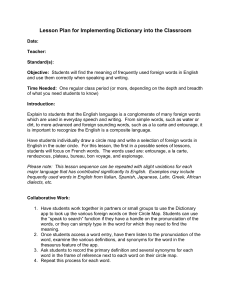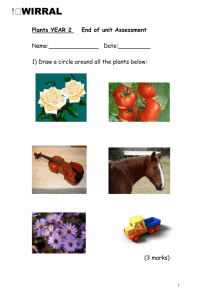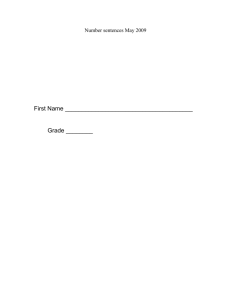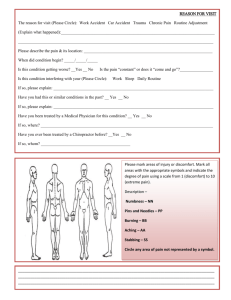Ecology Assignment: History of a Carbon Atom
advertisement
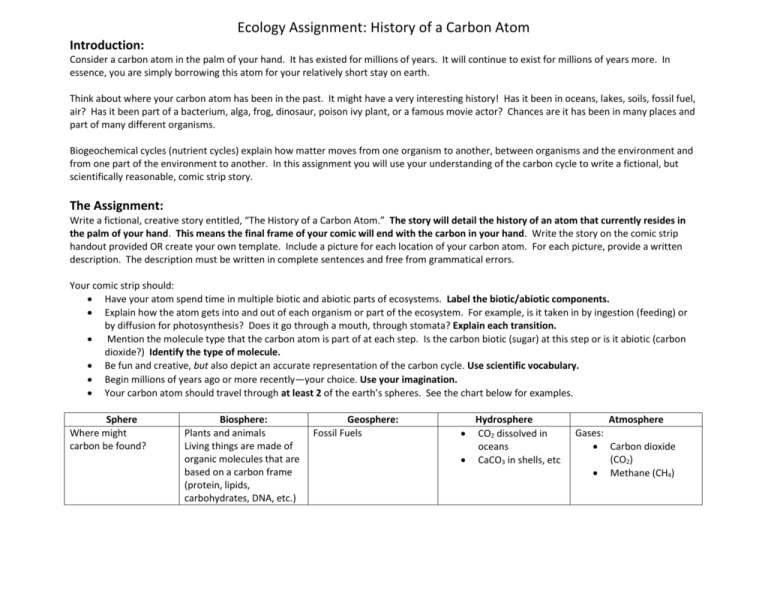
Ecology Assignment: History of a Carbon Atom Introduction: Consider a carbon atom in the palm of your hand. It has existed for millions of years. It will continue to exist for millions of years more. In essence, you are simply borrowing this atom for your relatively short stay on earth. Think about where your carbon atom has been in the past. It might have a very interesting history! Has it been in oceans, lakes, soils, fossil fuel, air? Has it been part of a bacterium, alga, frog, dinosaur, poison ivy plant, or a famous movie actor? Chances are it has been in many places and part of many different organisms. Biogeochemical cycles (nutrient cycles) explain how matter moves from one organism to another, between organisms and the environment and from one part of the environment to another. In this assignment you will use your understanding of the carbon cycle to write a fictional, but scientifically reasonable, comic strip story. The Assignment: Write a fictional, creative story entitled, “The History of a Carbon Atom.” The story will detail the history of an atom that currently resides in the palm of your hand. This means the final frame of your comic will end with the carbon in your hand. Write the story on the comic strip handout provided OR create your own template. Include a picture for each location of your carbon atom. For each picture, provide a written description. The description must be written in complete sentences and free from grammatical errors. Your comic strip should: Have your atom spend time in multiple biotic and abiotic parts of ecosystems. Label the biotic/abiotic components. Explain how the atom gets into and out of each organism or part of the ecosystem. For example, is it taken in by ingestion (feeding) or by diffusion for photosynthesis? Does it go through a mouth, through stomata? Explain each transition. Mention the molecule type that the carbon atom is part of at each step. Is the carbon biotic (sugar) at this step or is it abiotic (carbon dioxide?) Identify the type of molecule. Be fun and creative, but also depict an accurate representation of the carbon cycle. Use scientific vocabulary. Begin millions of years ago or more recently—your choice. Use your imagination. Your carbon atom should travel through at least 2 of the earth’s spheres. See the chart below for examples. Sphere Where might carbon be found? Biosphere: Plants and animals Living things are made of organic molecules that are based on a carbon frame (protein, lipids, carbohydrates, DNA, etc.) Geosphere: Fossil Fuels Hydrosphere CO2 dissolved in oceans CaCO3 in shells, etc Atmosphere Gases: Carbon dioxide (CO2) Methane (CH4) 1 2 3 4 Description 1: Description 2: Description 3: Description 4: 5 6 7 8 Description 5: Description 6: Description 7: Description 8: AUTHOR: ______________________________________________ Name______________________________ Grading Rubric Proficient Exceeds Mastery (14-15 points per category) (16-18 points per category) (19-20 points per category) Category Number of panels in the comic 4 panels 5-6 panels Score (circle): 14 Number of spheres addressed by the comic 15 2 spheres 15 Conventions/Creativity Score (circle): 16 -The comic contains 3-4 scientific errors. -1-2 relevant vocabulary words are missing from the descriptions of the movement of carbon between reservoirs. Score (circle): 14 Research and Understanding 7-8 panels 17 18 3 spheres Score (circle): 14 Scientific Accuracy Score (circle): 16 Score (circle): 19 20 3 spheres labeled 17 18 Score (circle): 19 20 -The comic contains 1-2 scientific errors. -Relevant scientific vocabulary is used to describe the transition between carbon reservoirs. -The comic does not contain scientific errors. -Detailed scientific vocabulary is used to describe carbon molecules and the transitions between reservoirs. Score (circle): 16 Score (circle): 19 15 17 18 20 -The comic is based solely on the diagrams provided in the textbook and in lecture. -student demonstrates a basic understanding of the carbon cycle -Some outside resources were used to develop a more detailed comic. -Student exceeds the basic knowledge of carbon cycle. -Significant additional research and/or reading were completed to develop comic. -Student demonstrates in-depth understanding of the movement of carbon through various reservoirs. Score (circle): 14 Score (circle): 16 Score (circle): 19 15 17 18 20 -3-4 errors in conventions -Comic lacks creativity and uniqueness. -1-2 Errors in conventions -Comic is creative and interesting to read. -Error free Conventions -Comic includes many creative and unique components. Student designed template. Score (circle): 14 Score (circle): 16 Score (circle): 19 15 17 18 20 TOTAL SCORE:_______________% Name______________________________ Grading Rubric Proficient Exceeds Mastery (14-15 points per category) (16-18 points per category) (19-20 points per category) Category Number of panels in the comic 4 panels Score (circle): 14 Number of spheres addressed by the comic Conventions/Creativity 7-8 panels 17 18 3 spheres 15 Score (circle): 16 -The comic contains 3-4 scientific errors. -1-2 relevant vocabulary words are missing from the descriptions of the movement of carbon between reservoirs. Score (circle): 14 Research and Understanding Score (circle): 16 2 spheres Score (circle): 14 Scientific Accuracy 5-6 panels 15 Score (circle): 19 20 3 spheres labeled 17 18 Score (circle): 19 20 -The comic contains 1-2 scientific errors. -Relevant scientific vocabulary is used to describe the transition between carbon reservoirs. -The comic does not contain scientific errors. -Detailed scientific vocabulary is used to describe carbon molecules and the transitions between reservoirs. Score (circle): 16 Score (circle): 19 15 17 18 20 -The comic is based solely on the diagrams provided in the textbook and in lecture. -student demonstrates a basic understanding of the carbon cycle -Some outside resources were used to develop a more detailed comic. -Student exceeds the basic knowledge of carbon cycle. -Significant additional research and/or reading were completed to develop comic. -Student demonstrates in-depth understanding of the movement of carbon through various reservoirs. Score (circle): 14 Score (circle): 16 Score (circle): 19 15 17 18 20 -3-4 errors in conventions -Comic lacks creativity and uniqueness. -1-2 Errors in conventions -Comic is creative and interesting to read. -Error free Conventions -Comic includes many creative and unique components. Student designed template. Score (circle): 14 Score (circle): 16 Score (circle): 19 15 17 18 TOTAL SCORE:_______________% 20


